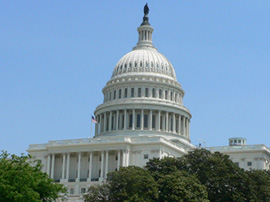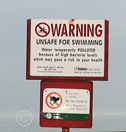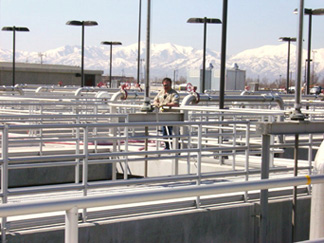Clean Water Act Progress and Challenges
Thirty-seven years after the passage of CWA, the nation's water quality has improved; however, according to an ASCE report infrastructure investments are lacking.
LeRoy W. Hooton, Jr.
May 29, 2009
|
However, with the formation of the Environmental Protection Agency (EPA) in 1970 and later, the passage of the Clean Water Act (CWA) in 1972 (and amended in 1977), the federal government undertook the task of cleaning up the nation's water. The goal of the CWA is to make all of the nation's water fishable and swimmable.
Other federal laws addresses air quality, safe drinking water and hazardous waste sites.
EPA's first priority was to reduce wastewater pollutants that were being discharged from publicly owned treatment works and industrial processes into the nation's waters by establishing national uniform technology-based effluent standards under a National Pollutant Discharge Elimination System (NPDES) permit for point source discharges.
Along with regulations and standards, the CWA also provided cost-sharing grants amounting to 75 percent for the construction of publicly owned treatment works. The subsidy was reduced to 55 percent in 1980, and the program ended in 1987. Nearly $70 billion in federal funds were spent in constructing wastewater treatment works across the United States. Non-federal spending for water and wastewater between 1991 and 2006 amounted to $841 billion.
In 1987, Congress passed legislation, amending the CWA to create State Water Pollution Control Revolving Funds (SRFs), which provide capitalization grants to states for financing the construction of wastewater treatment works and implementation of other water quality management activities. Under SRFs, the states contribute a 20 percent dollar match. These capitalization grants are used to provide loans and other types of financial assistance to local communities and inter-municipal and interstate agencies for qualified projects as determined by each state. Between 1988- 2007, as a result of loan repayments (with interest) and financial leveraging, federal and state contributions have provided up to 20,711 loans, financing $65 billion in clean water projects in the U.S. In the current federal budget, $4.4 billion is appropriated for the SRFs program.
|
The CWA has improved water quality. According to the EPA there has been measured improvement to the nation’s water. In 1972 only 36 percent of the water was safe for fishing and swimming – today 60 percent is safe for these uses. This has occurred despite a growing national population. However, there still remains 40 percent that does not meet the goals of the CWA. Moreover, raw sewage discharges continue to be a national problem. According to the EPA in 2004, overflows from communities with combined stormwater and sanitary sewer systems nationwide contribute 850 billion gallons per year discharged into the nation's surface waters. Sanitary sewer overflows caused by blocked or broken pipes result in releases of as much as 10 billion gallons of raw sewage.
In 1998, water pollution control shifted from end of the pipe treatment to watershed protection. In a report entitled "Clean Water Action Plan; Restoring and Protecting America's Waters,” initiatives were outlined for improving water quality by restoring and sustaining the health of watersheds in the nation. The premise of the program is that the water flowing from the watersheds feed into rivers, lakes, and coastal waters; and by keeping these sources of water clean, water quality will improve in the downstream waters.
The cost of clean water is increasing. Historically, regulations become more stringent, requiring investments in new technology and treatment works with higher O&M expenditures. Inflation further adds to the cost of clean water. Increasing operational costs cut into available capital to fund infrastructure improvements.
Despite federal and state contributions to the SRFs and other non-federal spending, capital investments for wastewater infrastructure improvements are falling short of those necessary to meet the goals of the CWA. According to the 2009 report entitled, “Report Card for American Infrastructure,” prepared by the American Society of Civil Engineers (ASCE), the nation's water and wastewater infrastructure gets a score of D-. The report reads, “Aging systems discharge billions of gallons of untreated wastewater into U.S. surface waters each year. EPA estimates that the nation must invest $390 billion over the next 20 years to update or replace existing [wastewater] systems and build new ones to meet increasing demand [population growth].” Moreover, the ASCE report states there is a projected $108.6 billion shortfall in projected spending during the next five years to meet the necessary water and wastewater infrastructure investments. This funding shortage could exceed $500 billion by 2020.
|
There has been substantial progress made towards making the nation's waters fishable and swimmable. Looking forward, the nation will be financially challenged to maintain the gains obtained during the past 37 years and further, be able to advance its clean water programs. As the ASCE report concludes, “If the nation fails to meet the investments needs of the next 20 years, it risks reversing public health, environmental, and economic gains of the past three decades.”
Salt Lake City's Compliance with the Clean Water Act
- Construction of the 45 MGD Water Reclamation plant was completed in 1965. It was operated under a state of Utah permit based on the Utah Water Pollution Control Act of 1952. The $7 million cost was financed by a special property tax levy.
- With the passage of the federal CWA in 1972, the Water Reclamation plant became regulated by EPA through a NPDES permit.
- In 1979, the Salt Lake City Sewer Division was transferred from the General Fund to the Department of Public Utilities and made an enterprise funded utility. As an enterprise fund, O&M and capital improvements to the system and plant are financed by rates and connection fees.
- On December 7, 1982 the City Council adopted an EPA 201 Facilities Plan, and on April 5, 1984 the EPA accepted the plan with a “Finding of No Significant Impact/Environmental Assessment Report.” Under the plan, $43.5 million in capital improvements were made to the Reclamation Plant.
- In 1983, industrial waste discharges into the city's sewage collection system and treatment plant became regulated under Salt Lake City's Pretreatment Ordinance
- On July 1, 1990 the drainage division was transferred from the General Fund to the Department of Public Utilities; and by ordinance passed by the City Council on July 1, 1991 was made an enterprise funded utility. The Stormwater Utility was formed in a response to the CWA. Salt Lake City was issued its stormwater NPDES permit on September 1, 1995.
- In 2008, the Water Reclamation Plant was upgraded with a $26 million new trickling filter/activated sludge treatment process, which will allow the treatment plant to meet the city's needs to the year 2020, based on existing NPDES permit requirements.
- The Water Reclamation Plant, by virtue of capital investments and the dedication, skill and professionalism of its employees has met its NPDES permit requirements without a violation for 15 consecutive years. At the end of 2008 the Water Reclamation Plant was recognized by receiving a NACWA Platinum Peak Performance Award NO. 15. In total the plant has 19 Gold Awards for operating a full calendar year without a permit violation.


